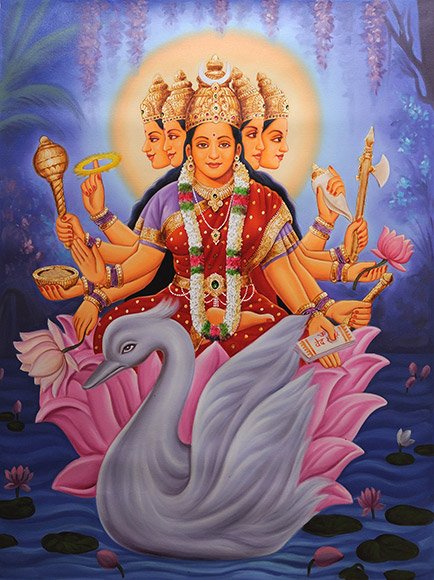Caru, Cāru, Cāṟu: 29 definitions
Introduction:
Caru means something in Hinduism, Sanskrit, Jainism, Prakrit, Buddhism, Pali, the history of ancient India, Marathi, Hindi, Tamil. If you want to know the exact meaning, history, etymology or English translation of this term then check out the descriptions on this page. Add your comment or reference to a book if you want to contribute to this summary article.
Alternative spellings of this word include Charu.
Images (photo gallery)
In Hinduism
Vastushastra (architecture)
Source: Wisdom Library: Vāstu-śāstraCāru (चारु) refers to a type of temple (prāsāda) classified under the group named Maṇika, according to Samarāṅgaṇasūtradhāra chapter 49. The Maṇika group contains ten out of a sixty-four total prāsādas (temples) classified under five prime vimānas (aerial car/palace), which were created by Brahmā for as many gods (including himself). This group represents temples (e.g. Cāru) that are to be globular and oblong in shape. The prāsādas, or ‘temples’, represent the dwelling place of God and are to be built in towns. The Samarāṅgaṇasūtradhāra is an 11th-century encyclopedia dealing with various topics from the Vāstuśāstra.

Vastushastra (वास्तुशास्त्र, vāstuśāstra) refers to the ancient Indian science (shastra) of architecture (vastu), dealing with topics such architecture, sculpture, town-building, fort building and various other constructions. Vastu also deals with the philosophy of the architectural relation with the cosmic universe.
Purana and Itihasa (epic history)
Source: archive.org: Puranic EncyclopediaCāru (चारु).—(CĀRUCITRA). A son of Dhṛtarāṣṭra, killed in war by Bhīmasena. (Mahābhārata Droṇa Parva, Chapter 136).
Source: archive.org: Nilamata Purana: a cultural and literary studyCaru (चरु) refers to a “preparation of all grains”, forming part of a common diet in ancient Kashmir (Kaśmīra) as mentioned in the Nīlamatapurāṇa.—Caru is a preparation of all grains, recommended as a gift for the Brāhmaṇas and the relatives (v. 502). Most of the references to the articles of diet occur in the Nīlamata in connection with the offerings made to the gods but it is not difficult to infer from them the food and drink of the common people because “what a man eats his gods eat”.
Source: Cologne Digital Sanskrit Dictionaries: The Purana Index1) Caru (चरु).—By a manipulation of Raudra-Vaiṣṇava offerings of Rāka, Jamadagni was born from Vaiṣṇavāgni;1 a ceremonial oblation.2
2) Cāru (चारु).—A son of Rukmiṇi. Went out to play and saw a huge lizard with his brothers and reported to Kṛṣṇa.*
- * Bhāgavata-purāṇa X. 61. 9; 64. 1-4; Brahmāṇḍa-purāṇa III. 71. 246. Vāyu-purāṇa 96. 237. Viṣṇu-purāṇa V. 28. 2.
Cāru (चारु) refers to one of the two sons of Śarmiṣṭhā (the daughter of Vṛṣaparvan) and Yayāti: one of the sons of Virajā and Nahuṣa, according to the Vaṃśānucarita section of the 10th century Saurapurāṇa: one of the various Upapurāṇas depicting Śaivism.—Accordingly, [...] Nahuṣa married Virajā (the daughter of Pitṛ) and was blessed with five sons of whom Yayāti was the most famous. Yayāti had two wives—Devayānī and Śarmiṣṭhā. Śarmiṣṭhā gave birth to Duhya, Cāru and Puru.

The Purana (पुराण, purāṇas) refers to Sanskrit literature preserving ancient India’s vast cultural history, including historical legends, religious ceremonies, various arts and sciences. The eighteen mahapuranas total over 400,000 shlokas (metrical couplets) and date to at least several centuries BCE.
Dharmashastra (religious law)
Source: Sacred Texts: The Grihya Sutras, Part 2 (SBE30)Caru (चरु) or Karu refers to “pulse”, mentioned as an example of a gift used in a Yajña (sacrifice), in the Āpastamba-yajña-paribhāṣā-sūtras 1.—“yajña [viz., iṣṭi], sacrifice, is an act by which we surrender something for the sake of the gods. Such an act must rest on a sacred authority (āgama), and serve for man’s salvation (śreyortha). The nature of the gift is of less importance. It may be puroḍāśa, cake; karu [viz., caru], pulse; sāṃnāyya, mixed milk; paśu, an animal; soma, the juice of the Soma-plant, &c.; nay, the smallest offerings of butter, flour, and milk may serve for the purpose of a sacrifice”.
Puroḍāśa is a cake made of meal (‘pakvaḥ piṣṭapiṇḍaḥ’), different from karu (caru), which is more of a pulse consisting of grains of rice or barley, and clarified butter (‘‘ghṛtataṇḍulobhayātmakam’). This puroḍāśa cake has to be divided for presentation to different deities. If there are more than two deities, the plural vyāvartadhvam, separate, has to be used.

Dharmashastra (धर्मशास्त्र, dharmaśāstra) contains the instructions (shastra) regarding religious conduct of livelihood (dharma), ceremonies, jurisprudence (study of law) and more. It is categorized as smriti, an important and authoritative selection of books dealing with the Hindu lifestyle.
Chandas (prosody, study of Sanskrit metres)
Source: Journal of the University of Bombay Volume V: Apabhramsa metres (2)Cāru (चारु) (also Lalataka) is the name of an Apabhraṃśa metre classified as Dvipadi (metres with two lines in a stanza) discussed in books such as the Chandonuśāsana, Kavidarpaṇa, Vṛttajātisamuccaya and Svayambhūchandas.—Cāru has 10 mātrās in a line, divided into groups of 5,5 mātrās.

Chandas (छन्दस्) refers to Sanskrit prosody and represents one of the six Vedangas (auxiliary disciplines belonging to the study of the Vedas). The science of prosody (chandas-shastra) focusses on the study of the poetic meters such as the commonly known twenty-six metres mentioned by Pingalas.
Shaktism (Shakta philosophy)
Source: Google Books: ManthanabhairavatantramCaru (चरु) refers to “sacrificial pap”, according to the Kulakaulinīmata, according to the Śrīmatottara-tantra, an expansion of the Kubjikāmatatantra: the earliest popular and most authoritative Tantra of the Kubjikā cult.—When the Yoginīs are pleased, the Command [i.e., ājñā] that the adept has received grows in intensity. This happens, for example, when he eats the sacrificial pap (caru) in the prescribed manner. This may also be a part of Siddhānta ritual. But in that case it is a vegetarian dish prepared from rice or boiled grains.
Note: Caru is the sacrificial food that the Yoginīs offer to their male counterparts in the sacred sites. Notice the contrast between this food and the bali that is offered to the Yoginīs. The sacrificial meal is an exchange of food. The worshipper makes his offering to appease, propitiate and worship the deity that responds by giving him sacred food in return that empowers and transforms him.

Shakta (शाक्त, śākta) or Shaktism (śāktism) represents a tradition of Hinduism where the Goddess (Devi) is revered and worshipped. Shakta literature includes a range of scriptures, including various Agamas and Tantras, although its roots may be traced back to the Vedas.
Shaivism (Shaiva philosophy)
Source: Brill: Śaivism and the Tantric Traditions1) Caru (चरु) refers to the “pure ritual gruel-offering”, according to the 9th-century Sarvajñānottaratantra chapter 18.—Accordingly, “Next, I shall teach the best observance among observances, which is known as the Śiva-vrata and which is revered by Asuras and Gods alike. Pure pale ash [should be used, and] white dress and unguents; he should wear a white sacred thread and be adorned by a chignon of matted locks. He should be equipped with all [suitable] ornaments, [and] adorned with white garlands; he should consume (bhuj) [only the pure ritual gruel-offering known as] caru; he should observe the chaste conduct of a student; he should venerate Śiva, the fire and his Guru. [...]”.
2) Cāru (चारु) refers to “pretty (decorative items)”, according to the 13th-century Matsyendrasaṃhitā: a Kubjikā-Tripurā oriented Tantric Yoga text of the Ṣaḍanvayaśāmbhava tradition from South India.—Accordingly, “[Visualisation of Parameśvara]:—[...] He is adorned with nice (cāru) anklets, armlets, rings and bracelets, and he shines with small toe rings, Channahīras, etc., and diadems and a crown. His face is gracious, beautiful, his lips are smeared with betel leaves. His mind is filled with the joy of wine, and his body is supreme bliss [itself]. [...]”.

Shaiva (शैव, śaiva) or Shaivism (śaivism) represents a tradition of Hinduism worshiping Shiva as the supreme being. Closely related to Shaktism, Shaiva literature includes a range of scriptures, including Tantras, while the root of this tradition may be traced back to the ancient Vedas.
Kavya (poetry)
Source: Brill: Śaivism and the Tantric Traditions (kavya)Cāru (चारु) refers to “magnificent”, according to Bāṇa’s Kādambarī (p. 225-226).—Accordingly, while describing the shire of the Goddess Caṇḍikā, “[Then follows the image of the Goddess Caṇḍikā, which matches the conception of Kālarātri in the passage from the Mahābhārata:] [...] she bore the coquettish apparel of a woman going out to meet Mahākāla at night, with a vine-like body furnished with a raiment reddened with saffron-dye, with a face with red eyes, whose brows were furrowed into a frown, whose lip was crimsoned with betel that was blood, whose cheeks were reddened by the light shed from ear-ornaments of pomegranate flowers, with a forehead on which there was a tilaka dot of vermillion made by a Śabara beauty, covered by a magnificent (cāru) gold turban. She was worshipped by goats... mice... antelope and black serpents... She was praised on all sides by flocks of old crows; [...]”.

Kavya (काव्य, kavya) refers to Sanskrit poetry, a popular ancient Indian tradition of literature. There have been many Sanskrit poets over the ages, hailing from ancient India and beyond. This topic includes mahakavya, or ‘epic poetry’ and natya, or ‘dramatic poetry’.
In Jainism
General definition (in Jainism)
Source: archive.org: Een Kritische Studie Van Svayambhūdeva’s PaümacariuCāru (चारु) participated in the war between Rāma and Rāvaṇa, on the side of the latter, as mentioned in Svayambhūdeva’s Paumacariu (Padmacarita, Paumacariya or Rāmāyaṇapurāṇa) chapter 57ff. Svayambhū or Svayambhūdeva (8th or 9th century) was a Jain householder who probably lived in Karnataka. His work recounts the popular Rāma story as known from the older work Rāmāyaṇa (written by Vālmīki). Various chapters [mentioning Cāru] are dedicated to the humongous battle whose armies (known as akṣauhiṇīs) consisted of millions of soldiers, horses and elephants, etc.

Jainism is an Indian religion of Dharma whose doctrine revolves around harmlessness (ahimsa) towards every living being. The two major branches (Digambara and Svetambara) of Jainism stimulate self-control (or, shramana, ‘self-reliance’) and spiritual development through a path of peace for the soul to progess to the ultimate goal.
India history and geography
Source: Cologne Digital Sanskrit Dictionaries: Indian Epigraphical GlossaryCaru.—(EI 10, 22, 23; CII 3, 4), an offering to the manes; one of the five mahāyajñas. Note: caru is defined in the “Indian epigraphical glossary” as it can be found on ancient inscriptions commonly written in Sanskrit, Prakrit or Dravidian languages.

The history of India traces the identification of countries, villages, towns and other regions of India, as well as mythology, zoology, royal dynasties, rulers, tribes, local festivities and traditions and regional languages. Ancient India enjoyed religious freedom and encourages the path of Dharma, a concept common to Buddhism, Hinduism, and Jainism.
Languages of India and abroad
Pali-English dictionary
Source: BuddhaSasana: Concise Pali-English Dictionarycāru : (adj.) charming; beautiful; pleasant.
Source: Sutta: The Pali Text Society's Pali-English DictionaryCāru, (adj.) (Vedic cāru & cāyu to *qe — *qā, as in kāma, Lat. carus, etc., see under kāma) charming, desirable, pleasant, beautiful J. VI, 481; Miln. 201; Sdhp. 428, 512; VvA. 36 (=vaggu), sucāru S. I, 181; Pv. II, 1212 (=suṭṭhumanorama).

Pali is the language of the Tipiṭaka, which is the sacred canon of Theravāda Buddhism and contains much of the Buddha’s speech. Closeley related to Sanskrit, both languages are used interchangeably between religions.
Marathi-English dictionary
Source: DDSA: The Molesworth Marathi and English Dictionarycaru (चरु).—m S Boiled rice. Ex. kiṃ hōmaśāḷēntūna śvāna || jāya carumātra ghēūna ||.
--- OR ---
cāru (चारु).—a S Beautiful, elegant, handsome--persons or things.
Source: DDSA: The Aryabhusan school dictionary, Marathi-Englishcaru (चरु).—m Boiled rice.
--- OR ---
cāru (चारु).—a Beautiful, handsome. cārugātra a Of elegant or handsome limbs.
Marathi is an Indo-European language having over 70 million native speakers people in (predominantly) Maharashtra India. Marathi, like many other Indo-Aryan languages, evolved from early forms of Prakrit, which itself is a subset of Sanskrit, one of the most ancient languages of the world.
Sanskrit dictionary
Source: DDSA: The practical Sanskrit-English dictionaryCaru (चरु).—[car un]
1) An oblation of rice or barley boiled for presentation to the gods and the manes; अनवस्रावी निरुष्मपक्व ओदनश्चरुरिति याज्ञिकाः ओदनेऽपि चरुशब्दः प्रयुज्यते (anavasrāvī niruṣmapakva odanaścaruriti yājñikāḥ odane'pi caruśabdaḥ prayujyate) | ŚB. on MS.1.1.36. (It is often boiled in milk and is called payaścaru; cf. R.1.51,54,56; or sprinkled over with butter or ghee); वन्यैश्चरुपुरोडाशैः (vanyaiścarupuroḍāśaiḥ) Bhāgavata 11.18.7.
2) A kind of vessel in which an oblation is prepared. प्रसिद्धश्च स्थाल्यां चरुशब्दः आ च हिमवतः आ च कुमारीभ्यः प्रयुज्य- मानो दृष्टः (prasiddhaśca sthālyāṃ caruśabdaḥ ā ca himavataḥ ā ca kumārībhyaḥ prayujya- māno dṛṣṭaḥ) | ŚB. on MS.1.1.35.
3) A cloud.
Derivable forms: caruḥ (चरुः).
--- OR ---
Cāru (चारु).—a. (-ru or -rvī f.) [चरति चित्ते चर् उण् (carati citte car uṇ) cf. Uṇādi-sūtra 1.3.]
1) Agreeable, welcome, beloved, esteemed, dear (with dat. or loc.); वरुणाय (varuṇāya) or वरुणे चारुः (varuṇe cāruḥ).
2) Pleasing, lovely, beautiful, elegant, pretty; प्रिये चारुशीले मुञ्च मयि मानमनि- दानम् (priye cāruśīle muñca mayi mānamani- dānam) Gītagovinda 1; सर्वं प्रिये चारुतरं वसन्ते (sarvaṃ priye cārutaraṃ vasante) Ṛtusaṃhāra 6.2; चकासतं चारु चमूरुचर्मणा (cakāsataṃ cāru camūrucarmaṇā) Śiśupālavadha 1.8;4.49.
-ruḥ An epithet of Bṛhaspati.
-ru n. Saffron.
Source: Cologne Digital Sanskrit Dictionaries: Edgerton Buddhist Hybrid Sanskrit DictionaryCāru (चारु).—name of a cakravartin king: Mahāvyutpatti 3559. Seems to correspond to Pali Cara, or Caraka Mahāv. ii.2. Cf. Upacāru.
Source: Cologne Digital Sanskrit Dictionaries: Shabda-Sagara Sanskrit-English DictionaryCaru (चरु).—m.
(-ruḥ) 1. An oblation of rice barley, and pulse, boiled with butter and milk for presentation to the gods or manes. 2. The vessel in which such an oblation is prepared. E. car to eat, uṇ Unadi affix, what the gods feed upon.
--- OR ---
Cāru (चारु).—mfn. (-ruḥ-rvī-ru) 1. An agreeable, welcome, dear. 2. Beautiful, elegant. m.
(-ruḥ) A name of Vrihaspati, regent of Jupiter, and preceptor of the gods. E. car to go, Unadi affix uṇ.
Source: Cologne Digital Sanskrit Dictionaries: Benfey Sanskrit-English DictionaryCaru (चरु).—m. 1. A caldron, [Mānavadharmaśāstra] 5, 117. 2. An oblation to the gods, chiefly of milk and butter, [Mānavadharmaśāstra] 6, 11.
--- OR ---
Cāru (चारु).— (akin to car in carv, cf. cūrṇa, properly: Delicate, cf. ), adj., f. rvī. 1. Agreeable, [Pañcatantra] 256, 14. 2. Beautiful, [Rāmāyaṇa] 1, 63, 6.
Source: Cologne Digital Sanskrit Dictionaries: Cappeller Sanskrit-English DictionaryCaru (चरु).—[masculine] pot, kettle; sacrificial food, [especially] boiled rice.
--- OR ---
Cāru (चारु).—[adjective] pleasant, lovely, beautiful, dear; [neuter] [adverb]
Source: Cologne Digital Sanskrit Dictionaries: Monier-Williams Sanskrit-English Dictionary1) Caru (चरु):—m. ([gana] bhīmādi) a kind of vessel (in which a particular oblation is prepared), saucepan, pot, [Ṛg-veda; Atharva-veda; Śatapatha-brāhmaṇa xiii; Kātyāyana-śrauta-sūtra; Kauśika-sūtra; Manu-smṛti; Yājñavalkya]
2) a cloud (cf. [Ṛg-veda i, 7, 6]), [Naighaṇṭuka, commented on by Yāska i, 10]
3) an oblation (of rice, barley and pulse) boiled with butter and milk for presentation to the gods or manes, [Vājasaneyi-saṃhitā xxix. 6; Taittirīya-saṃhitā i; Śatapatha-brāhmaṇa; Aitareya-brāhmaṇa i, 1 & 7; Kātyāyana-śrauta-sūtra] etc. ([plural] [Yājñavalkya i, 298]).
4) Cāru (चारु):—mf(us)n. (√2. can) agreeable, approved, esteemed, beloved, endeared, ([Latin]) carus, dear (with [dative case] or [locative case] of the person), [Ṛg-veda; Vājasaneyi-saṃhitā xxxv, 17; Taittirīya-saṃhitā iii; Taittirīya-brāhmaṇa iii, 1, 1, 9; Śāṅkhāyana-śrauta-sūtra i, 5, 9]
5) pleasing, lovely, beautiful, pretty, [Ṛg-veda; Atharva-veda; Mahābhārata] etc.
6) ind. so as to please, agreeably (with [dative case]), [Ṛg-veda ix, 72, 7 and 86, 21; Atharva-veda vii, xii, xiv]
7) beautifully, [Harivaṃśa; Caurapañcāśikā]
8) m. (in music) a particular vāsaka
9) Name of Bṛhaspati, [cf. Lexicographers, esp. such as amarasiṃha, halāyudha, hemacandra, etc.]
10) of a son of Kṛṣṇa, [Harivaṃśa 6699; Bhāgavata-purāṇa x, 61, 9]
11) of a Cakra-vartin, [Buddhist literature]
12) n. ([varia lectio] for vara) saffron, [cf. Lexicographers, esp. such as amarasiṃha, halāyudha, hemacandra, etc. [Scholiast or Commentator]]
Source: Cologne Digital Sanskrit Dictionaries: Yates Sanskrit-English Dictionary1) Caru (चरु):—(ruḥ) 2. m. An oblation of rice with butter and milk; or the vessel for such oblation.
2) Cāru (चारु):—[(ruḥ-rvvī-ru) a.] Beautiful, elegant. 2. m. Vrihashpati.
Source: DDSA: Paia-sadda-mahannavo; a comprehensive Prakrit Hindi dictionary (S)Caru (चरु) in the Sanskrit language is related to the Prakrit words: Caru, Cāru.
[Sanskrit to German]
Sanskrit, also spelled संस्कृतम् (saṃskṛtam), is an ancient language of India commonly seen as the grandmother of the Indo-European language family (even English!). Closely allied with Prakrit and Pali, Sanskrit is more exhaustive in both grammar and terms and has the most extensive collection of literature in the world, greatly surpassing its sister-languages Greek and Latin.
Hindi dictionary
Source: DDSA: A practical Hindi-English dictionaryCāru (चारु) [Also spelled charu]:—(a) beautiful, appealing, attractive, charming; hence ~[tā] (nf), ~[tva] (nm).
...
Prakrit-English dictionary
Source: DDSA: Paia-sadda-mahannavo; a comprehensive Prakrit Hindi dictionary1) Caru (चरु) in the Prakrit language is related to the Sanskrit word: Caru.
2) Cāru (चारु) also relates to the Sanskrit word: Cāru.
Prakrit is an ancient language closely associated with both Pali and Sanskrit. Jain literature is often composed in this language or sub-dialects, such as the Agamas and their commentaries which are written in Ardhamagadhi and Maharashtri Prakrit. The earliest extant texts can be dated to as early as the 4th century BCE although core portions might be older.
Kannada-English dictionary
Source: Alar: Kannada-English corpusCaru (ಚರು):—[noun] a kind of small fish .
--- OR ---
Caru (ಚರು):—
1) [noun] anything that is offered to a god as an oblation.
2) [noun] a vessel used for offering an oblation ( in a sacrifice).
3) [noun] the offering of an animal as in propitiation or homage.
4) [noun] (fig.) food; meal.
--- OR ---
Cāru (ಚಾರು):—
1) [adjective] 'giving delight; very pleasing; delightful: charming.'2) [adjective] outstandingly good of its kind; of superior merit, virtue, etc.; excellent.
Kannada is a Dravidian language (as opposed to the Indo-European language family) mainly spoken in the southwestern region of India.
See also (Relevant definitions)
Starts with (+237): Caru velai, Caru-karunatacarankam, Carua, Carubahu, Carubhadra, Carubhanu, Carubhuj, Carucam, Carucampaka, Carucandra, Carucapam, Carucapi, Carucapikam, Carucarana, Carucaritra, Carucarya, Carucaryashataka, Caruccarai, Carucchada, Carucelin.
Ends with (+33): Acaru, Accaru, Aicaru, Arruttumatti caru, Aticaru, Avacaru, Aycaru, Beccaru, Bhadracaru, Canakaccaru, Ceccaru, Civappuccaru, Divyacaru, Dugdhacaru, Eccaru, Elcaru, Katteccaru, Kocaru, Komcaru, Kucaru.
Full-text (+628): Carusthali, Carushila, Carulocana, Ajamoda, Carugupta, Caruphala, Caruvrana, Caruka, Caruvrata, Carugarbha, Carudhara, Carubahu, Caruta, Carvaghata, Carudeva, Carughona, Caruvardhana, Carurava, Caruvinda, Acaru.
Relevant text
Search found 79 books and stories containing Caru, Cāru, Cāṟu; (plurals include: Carus, Cārus, Cāṟus). You can also click to the full overview containing English textual excerpts. Below are direct links for the most relevant articles:
Rig Veda (translation and commentary) (by H. H. Wilson)
Brihad Bhagavatamrita (commentary) (by Śrī Śrīmad Bhaktivedānta Nārāyana Gosvāmī Mahārāja)
Verse 2.2.49 < [Chapter 2 - Jñāna (knowledge)]
Verse 2.3.77 < [Chapter 3 - Bhajana (loving service)]
Verse 2.4.67 < [Chapter 4 - Vaikuṇṭha (the spiritual world)]
Rudra-Shiva concept (Study) (by Maumita Bhattacharjee)
3e. Oblation to Soma-Rudra (Somāraudra-yāga) < [Chapter 4 - Rudra-Śiva in the Post-Brāhmaṇic Literature]
4h. Rudra, for the cure of disease < [Chapter 4 - Rudra-Śiva in the Post-Brāhmaṇic Literature]
3. Rudra in the Taittirīya-saṃhitā (Introduction) < [Chapter 2 - Rudra-Śiva in the Saṃhitā Literature]
Apastamba Yajna-paribhasa-sutras (by Hermann Oldenberg)
The Skanda Purana (by G. V. Tagare)
Chapter 166 - Birth of Paraśurāma < [Section 1 - Tīrtha-māhātmya]
Chapter 12 - Uninterrupted Ekādaśī Vow < [Section 5 - Mārgaśīrṣa-māhātmya]
Chapter 167 - Viśvāmitra Renounces Kingdom < [Section 1 - Tīrtha-māhātmya]
The Brahmanda Purana (by G.V. Tagare)
Chapter 66 - Description of Amāvasu dynasty (vaṃśa) < [Section 3 - Upodghāta-pāda]
Chapter 1 - Birth of seven sages (saptarṣi): Race of Bhṛgu and Aṅgiras < [Section 3 - Upodghāta-pāda]
Chapter 28 - Meeting of Purūravas and Pitṛs < [Section 2 - Anuṣaṅga-pāda]
Related products
(+1 more products available)






